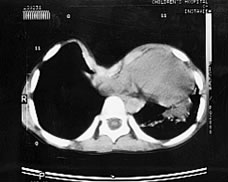
Pectus Excavatum
What is pectus excavatum?
Pectus excavatum is a pectus deformity. In pectus excavatum (funnel chest) the sternum (breastbone) is depressed in a concave shape. There may be asymmetry of the chest and the sternum may be rotated. The deformity varies in severity, ranging from a mild indentation/protrusion to severe, for example, a patient with a severe pectus excavatum may have only a few centimeters between his/her sternum and vertebral column. Severe cases of pectus excavatum can eventually interfere with the function of the heart and lungs. Most patients have a slim chest, a slouching posture and younger children commonly have potbellies. Pectus deformities are very common and can be found in approximately one out of every 400 people across the world. These deformatries are more frequently found in boys than girls, 4:1.
What causes pectus excavatum?
The deformity is thought to be caused by excessive growth of the costal cartilages although the reason for this is unknown. This overgrowth causes the ribs and cartilages to ‘buckle’ and pushes the sternum either inwards or outwards. Musculoskeletal abnormalities that are associated with pectus deformities are scoliosis (lateral curvature of the spine), Marfan’s syndrome (an inheritable disorder of the connective tissue), and Poland’s syndrome.
Does the deformity become worse over time?
The deformity is often noticeable at birth but becomes more apparent during the period of rapid skeletal growth in early adolescence. In one sample, 88% of patients stated their deformity was seen during the first few months of life (Fonkalsrud 2000). After the age of approximately 18 years of age, the deformity remains the same although most adults with pectus excavatum have been aware of their condition for years. Gaining weight and chest hair (in men) usually reduces the appearance of the deformity. Symptoms can sometimes get worse with age as the ribs push on the lungs and heart.
Will exercise and weight training improve pectus excavatum?
Exercise will not cure pectus excavatum, but it can improve poor posture and may slow the progression of mild to moderate conditions. Regular exercise can also lessen problems with breathing or exercise stamina. We certainly encourage physical therapy after the Nuss procedure has been performed and living a healthy, active lifestyle.




